Ijraset Journal For Research in Applied Science and Engineering Technology
- Home / Ijraset
- On This Page
- Abstract
- Introduction
- Conclusion
- References
- Copyright
Hardware Implementation of Green Building Using IOT Technology
Authors: Lovely Vijay Banta, Sparsh Verma, Amish Kumar, Rishu , Dhananjay Sharma, Harish Thakur, Manish Chauhan
DOI Link: https://doi.org/10.22214/ijraset.2024.63362
Certificate: View Certificate
Abstract
The integration of Internet of Things (IoT) technology into green building systems offers immense potential for optimizing energy consumption, enhancing sustainability, and improving occupant comfort. This paper presents a hardware-centric approach to implementing green building features through IoT components. Through collaboration, innovation, and commitment to sustainability, green building projects pave the way towards a more resilient and harmonious relationship between human development and the natural world.
Introduction
I. INTRODUCTION
Green building can also be referred as ‘green construction’ or ‘sustainable building’. Their development helps in reducing reliance on fossil fuels and also helps in reducing the total negative effect on environment. The objective of green building is to improve the resident quality of the life through environmental friendly developments. Buildings which are not build sustainably can have a major impact on occupants, health, safety, comfort and productivity. Green building comes with many practices, methods and skills which teaches us lesson to eliminate the building impacts on human health and environment. The construction and technologies used in green building are developing constantly. The Indian government's initiative to establish smart cities underscores this commitment, with a mandate for 70-80% of buildings to adhere to green standards. Green building practices encompass various stages, including design, construction, operation, and maintenance, emphasizing a comprehensive approach to sustainability in the built environment [1]. Top of Form
Bottom of Form
Green building has been instrumental in efforts to mitigate the deterioration of our planet. While the construction of green buildings has significantly enhanced human life quality, it's also important to acknowledge that they inevitably consume considerable resources, generate substantial waste, and pose risks to ecology and the environment.
The goal of green building is to maximize resource conservation, encompassing energy, land, water, and materials. In today's dynamic world, ongoing technological advancements complement existing practices, enhancing the creation of environmentally friendly structures. The overarching aim of green building is to minimize the collective impact of buildings on human health and the natural environment. Green building employs various techniques and expertise to effectively mitigate environmental and health impacts. These methods include harnessing sunlight through passive solar design, active solar systems, and photovoltaic technology, as well as integrating vegetation such as green roofs, rain gardens, and measures to reduce rainwater runoff [6].
This scholarly investigation delves into the implementation of green building practices within the framework of sustainable development in India. It delves into the fundamental principles and objectives of green building, focusing on aspects such as
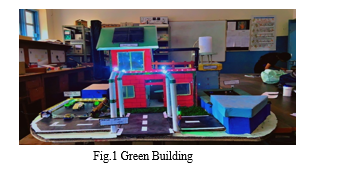
Energy efficiency, resource conservation, water management, and environmental quality. The research methodology involves a comprehensive analysis of both primary and secondary data sources, including interviews, surveys, and literature reviews. Through this approach, the study aims to shed light on the economic, political, technological, social, legal, and environmental dimensions relevant to green building practices in India, ultimately providing recommendations to bolster their sustainability [6].
A. The Energy Consumption in Residential Buildings
The residential building sector currently accounts for less than 25% of amount of total electricity usage, making it the third-largest consumer in terms of electricity usage. Between 2014 and 2017, there was a notable 26% increase in energy consumption within this sector. This surge can be attributed to factors such as population growth, rapid urbanization, and the resulting strain on electricity supply, leading to a significant demand-supply gap. The rising demand for electricity is largely driven by evolving living standards and a growing reliance on thermal comfort affordability. Projections indicate a substantial community increase in India, with largest estimation suggesting of community of 1.72 billion by the year of 2060. Urban expansion and urbanization are accelerating, with expectations that two-thirds of India's population will reside in urban areas by the year of 2050. This urbanization trend is poised to increase the urban population from 33% to 50% by 2050, with over 70 million of new urban housing units anticipated in the next two decades. Consequently, it is estimated that two-thirds of the developed area will be developed within this timeframe [3].
B. Energy Efficient Buildings
To enhance the energy efficiency of buildings, a plethora of technological solutions are readily available. Green building encompasses several key elements, including occupant safety and health, construct the efficiency, energy efficiency, sustainable site selection, materials efficiency, and water efficiency. Buildings that prioritize providing a healthy environment throughout their lifespan are termed green or energy-efficient buildings. These structures are designed to optimize the utilization of water, land, and energy resources. Green building designs leverage the natural resources and conditions of the site prior to construction. The benefits of environmentally friendly buildings extend to reducing the risk of respiratory illnesses such as asthma, as well as improving indoor air quality by minimizing emissions of toxic gases. It's imperative to prioritize good building design to mitigate the adverse health effects associated with such emissions and to enhance indoor air quality [3].
Top of Form
Bottom of Form
Some key requirements and initiatives related to green buildings in India:
- IGBC Green Building Rating System: The IGBC Green Building Rating System encompasses a range of rating systems tailored to different building types, including IGBC Green Homes, IGBC Green Factories, and IGBC Green Townships, among others. Each rating system offers specific guidelines and criteria aimed at facilitating the design, construction, and operation of buildings in an environmentally sustainable manner. These systems serve as valuable tools for ensuring that buildings adhere to eco-friendly practices and contribute positively to environmental conservation efforts.
- LEED India: LEED (Leadership in Energy and Environmental Design) stands as a globally acclaimed green building certification system, offering guidelines for building design and construction. LEED India specifically emphasizes water conservation, energy efficiency, sustainable materials selection, and indoor environmental air quality, providing a comprehensive framework to ensure eco-friendly practices in the built environment [10].
- Solar Energy Requirements: The Indian government has been promoting the use of solar energy in buildings through various initiatives such as the Solar Rooftop Photovoltaic (PV) Program. Under this program, building owners are encouraged to install rooftop solar panels to generate clean energy and reduce dependency on grid electricity.
- Water Conservation Measures: Green building requirements in India also focus on water conservation. This includes measures such as rainwater harvesting, wastewater recycling and reuse, and efficient water fixtures to minimize water consumption in buildings.
- Waste Management: Within green building standards, waste management protocols frequently incorporate strategies like recycling and composting. These measures aim to reduce the environmental repercussions of construction and operational endeavours by effectively managing waste streams. Through these practices, the emphasis is placed on minimizing waste generation and fostering sustainable resource utilization throughout the building's lifecycle.
- Green Material and Technologies: Green building requirements emphasize the use of sustainable and eco-friendly materials, as well as innovative technologies to increase energy efficiency and reduce environmental impact.
The overall requirement of green building in India is to promote eco-friendly development, reduces resources consumption, and minimizes environmental impact while enhancing occupant comfort and well being.
C. Merits of Green Building
- Environmental Benefits
a. Energy Efficiency: Energy efficiency is a hallmark of green buildings, achieved through various means such as optimized insulation, advanced lighting systems, and efficient heating and cooling mechanisms. This results in decreased energy consumption, thereby lowering greenhouse gas emissions and alleviating pressure on natural resources.
b. Water Conservation: Water conservation is integral to green building design, featuring innovative fixtures and systems that promote efficient water usage. These include the integration of low-flow toilets and the implementation of rainwater harvesting techniques. By adopting such measures, green buildings effectively reduce water consumption and alleviate pressure on local water supplies.
c. Waste Reduction: They often utilize recycled or renewable materials, minimize construction waste through efficient design and construction practices, and encourage recycling and composting, reducing landfill waste.
2. Economic Benefits: Green buildings often result in decreased operational expenses, primarily attributable to diminished utility bills stemming from lower energy and water consumption. This translates to significant long-term cost conservations for both building owners and tenants.
3. Health and Well-being: Improved Indoor Air Quality: Green buildings place a premium on indoor air quality by emphasizing effective ventilation, filtration systems, and the utilization of low-VOC (volatile organic compound) materials. These practices contribute to healthier indoor environments, mitigating respiratory issues and enhancing the overall well-being and comfort of occupants. Enhanced Thermal Comfort: Green buildings are often constructed to maintain consistent indoor heat and humidity levels, creating more comfortable living and working environments.
4. Social Benefits: Community Engagement: Green building projects often involve community stakeholders in the design and planning process, fostering a sense of ownership and pride in the built environment.
5. Job Creation: The green building sector fosters job creation by generating demand for skilled labour across various fields, such as architecture, engineering, construction, and the production of sustainable building materials. This not only stimulates economic growth but also promotes local employment opportunities and strengthens community development initiatives.
6. Equity and Accessibility: Green building practices can promote inclusivity by considering the needs of diverse populations, including individuals with disabilities and those from marginalized communities, ensuring equitable access to safe, healthy, and sustainable spaces.
II. METHODOLOGICAL APPROACHES
Green building methodology refers to the systematic approach and principles used in designing, constructing, operating and maintaining environmentally sustainable buildings. Research methodology on green building typically involves a structured approach to gathering, utilizing, and interpreting information to address specific inevstigated questions or objectives related to sustainable construction practices. This manuscript systematically reviews and assesses scientific literature pertaining to green buildings (GBs) within the framework of sustainable development from 1987 to 2022. Through a rigorous search process, relevant publications focusing on applied engineering principles and the efficient utilization of renewable resources were selected. The objective is to bolster the progression and adoption of sustainable development practices, green building concepts, and features of the circular economy. To accomplish this, extensive and credible databases were utilized, employing predefined algorithms in conjunction with the Boolean AND operator to refine search results.
By employing diverse electronic components in methodological research within India holds promise for revolutionizing the understanding and implementation of green building practices. Through systematic exploration and integration of these components, we can unlock new insights, optimize resource utilization, and proper sustainable development to incomparable heights. Embracing innovation and collaboration in this endeavour will surface the way for a greener, smarter, and more resilient built environment in India and beyond. In Green Building project we had implemented different IoT components which involve integrating various smart technologies to optimize energy usage, enhance sustainability, and improve overall efficiency in building operations.
A. Solar Charger Circuit
In this hardware project, we enabled an IoT solar energy system which a crucial role in harnessing renewable energy to reduce reliance on traditional power sources and minimize the building's carbon footprint. Here's how IoT components can enhance the efficiency and effectiveness of a solar system within a green building and shown in Fig .2
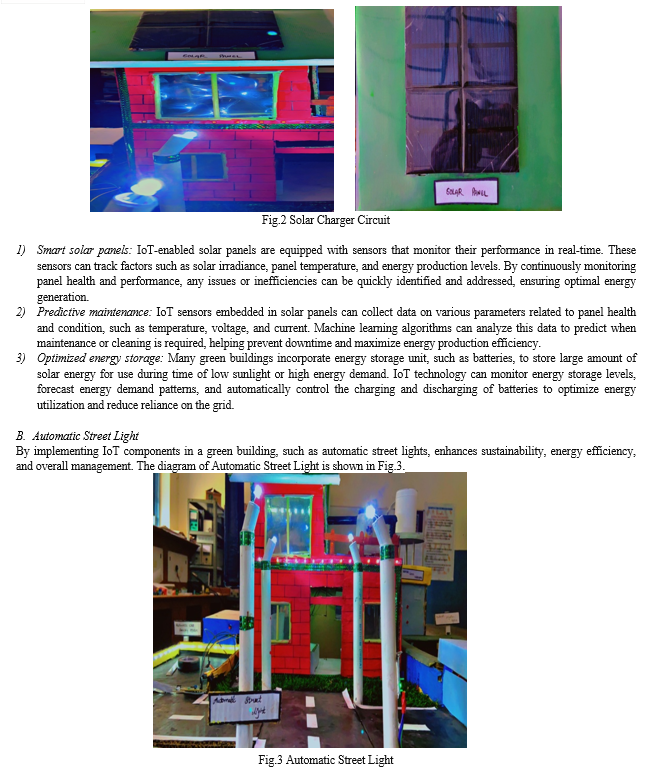
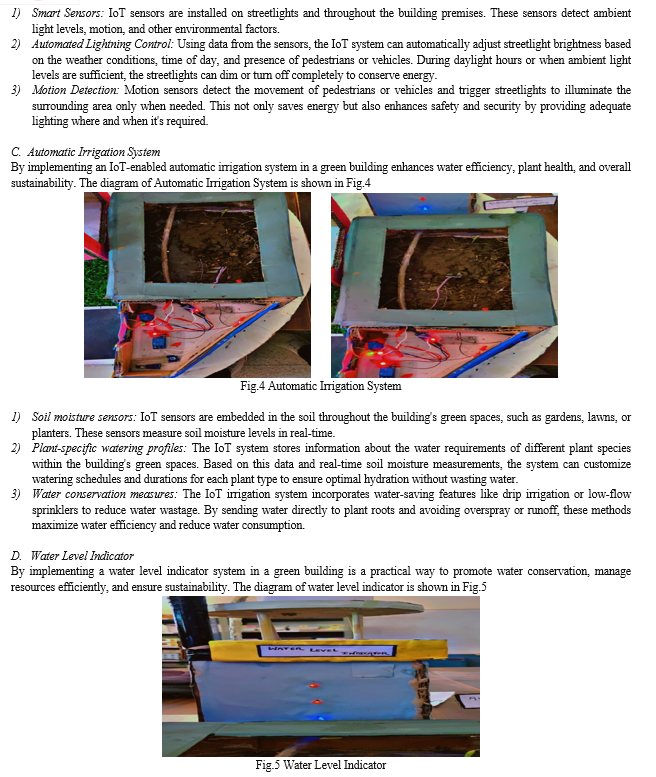


III. WORKING OF PROPOSED MODEL
Implementing a hardware model for a green building utilizing IoT components involves a comprehensive deployment strategy of sensors and actuators throughout the infrastructure. Sensors are strategically placed to capture dynamic data on the basis of various environmental parameters such as temperature, humidity, light intensity, air quality, occupancy, and energy usage. These sensors, typically connected wirelessly to a central IoT hub or gateway, form the backbone of the system. Data collected from these sensors undergoes pre-processing at the gateway, where it is filtered, aggregated, and cleaned before being transmitted to either a cloud-based platform or a local server for in-depth analysis.
This analysis phase involves employing advanced algorithms and machine learning models to extract actionable insights regarding energy consumption patterns, resource utilization, and building occupancy trends. Based on the analysis results, the system makes informed decisions to optimize the building's performance and reduce its environmental footprint.
Control signals are then relayed to actuators and IoT devices to dynamically adjust various building systems such as HVAC, lighting, and water management. User interaction is facilitated through intuitive interfaces like web dashboards or mobile apps, empowering occupants to monitor building performance, adjust settings, and receive feedback on their sustainability efforts. Continuous monitoring and optimization ensure that the system remains adaptive to changing conditions, thereby maximizing energy efficiency and occupant comfort while minimizing environmental impact.
Green buildings are developed and engineered with a target on reducing their environmental impact while promoting occupant health and well-being. Green building practices can be classified into various types based on their focus and objectives.
1) Site selection: Site selection for green building projects involves a comprehensive evaluation of various factors to ensure environmental sustainability and promote overall well-being. One critical consideration is the site's accessibility and connectivity, aiming to minimize the carbon footprint located with shipment and foster community engagement. Overall, strategic site selection plays a pivotal role in the success of green building initiatives, shaping the built environment in harmony with nature while promoting sustainable living practices.
2) Energy Management: IoT sensors can monitor energy consumption in real-time, allowing for better management of electricity, heating, and cooling systems. Smart heat controller can adjust temperature settings based on tenancy and external weather patterns to optimize energy usage. Automated lighting systems can adjust lighting levels according to the natural light availability and tenancy, minimizing unnecessary energy consumption.
3) Water Management and Waste Management: IoT-enabled water sensing devices can supervise water usage and detect leakage, helping to conserve water and prevent wastage. Smart irrigation systems can change watering schedules based on weather patterns and soil moisture levels, optimizing water usage for landscaping. IoT sensors can track waste generation and disposal patterns, enabling better waste management practices.
4) Indoor Air Quality: IoT sensors can monitor indoor air quality metrics such as humidity, CO2 levels, and particulate matter concentrations.
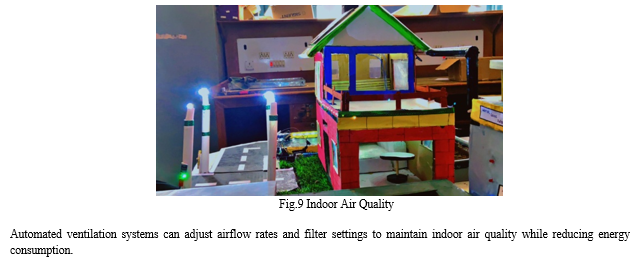
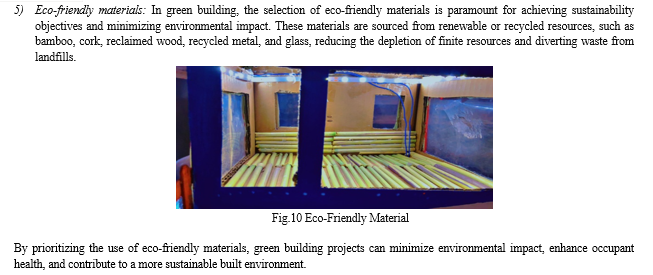
A. Top Of Form Bottom Of Form The Flop Cases And Necessity Of Green Building
- Flop Cases of Green Building
The Gherkin building in London, created in 2003 by Foster & Partner, initially planned for an open-floor draft system. However, during engineered, safety concerns and expenditure considerations led to the closure of all potentially open able windows, rendering the original ventilation design ineffective. This deviation from the green building concept resulted in worsened ventilation and increased energy consumption due to the need for additional artificial ventilation systems. Despite its idealistic design, the practicality and feasibility were overlooked, leading to outcomes contrary to the intended sustainability goals. Similarly, the Federal Building in Youngstown, Ohio, received authentication from the United States Green Building Council (USGBC) for its power-efficient features, including a white roof and reliance on natural light. However, subsequent investigation revealed high utility bills attributed to the power-intensive operation of the cooler system, prompting the removal of its Energy Star designation. These cases underscore the importance of long-term perspective in assessing green buildings, encompassing design considerations, monitoring records, and maintenance practices post-commissioning. Such comprehensive evaluations are essential for ensuring the true sustainability and effectiveness of green building initiatives in the future [7].
2. The Environmental Requirement of Green Buildings
Environmental considerations have evolve pivotal in evaluating green buildings. In the developmental journey, the environment serves as the fundamental framework for all life forms, and buildings, being the providers of living spaces, occupy a central role within this framework. Sustainable building development necessitates a comprehensive embrace of green design principles, spanning from the selection of raw construction materials to the adoption of environmentally optimized technologies. Furthermore, with urban land becoming increasingly scarce, there arises a critical need to optimize land resource planning without compromising environmental integrity. At the heart of green building design lies the imperative to minimize the utilization of organic resources while fulfilling the functional requirements of the building through innovative design approaches [7].
3. The Social Necessity of Green Buildings
In the era of big data, the emergence of intelligent buildings has taken center stage, marking a trend where buildings are progressively integrating intelligence seamlessly. This evolution sees a convergence of green and intelligence, as advanced green buildings merge environmental consciousness with smart technologies. The concept of green intelligence encompasses technological advancements, leveraging computer network control to monitor and regulate building energy consumption, indoor environments, and air quality remotely. This fusion not only translates green principles into practical application but also manifests in tangible data outcomes, underpinning the synergy between sustainability and technological innovation within the built environment [7].
4. The Economic Necessity of Green Buildings
While economic development may appear peripheral to green building, its rapid advancement inevitably fosters a quest for more conducive living environments. Green building design principles should prioritize human health, ensuring comfortable spaces with fresh air. Addressing concerns such as the cost of design solutions is crucial, emphasizing operability within effective cost controls. Opting for the most efficient design solutions under these circumstances facilitates sustainable economic development in the long run.
The ecological essence of green buildings underscores a commitment to ecological harmony, encompassing respect for ecological laws and safeguarding the environment throughout the design, construction, and operational phases. This involves tailoring designs to local conditions, integrating climatic and geographical attributes, maximizing natural lighting and ventilation to curtail energy consumption and pollution.
Material selection favours environmentally friendly options, coupled with efficient resource recycling practices and minimal waste discharge, promoting responsible resource utilization and recycling practices.
B. Characteristics of Some Green Buildings in India
- Suzlon One Earth,Pune: Located in Pune, Suzlon One Earth stands as a testament to sustainable practices, relying entirely on renewable energy sources both on location and off location. The campus boasts 18 fusion wind turbines, catering to 7% of its total energy needs, with the remaining desire met by off location wind turbines. Its architectural design prioritizes maximal daylight exposure, significantly reducing the reliance on artificial lighting. Moreover, the infrastructure layout facilitates water percolation, effectively managing stormwater runoff and positively impacting the local water table levels.
- Rajiv Gandhi International Airport (RGIA), Hyderabad: Hyderabad's Rajiv Gandhi International Airport (RGIA) is strategically designed to minimize water and electricity consumption while prioritizing the conservation of natural resources. Spanning over 273 hectares, the airport campus hosts a lush green belt adorned with a variety of plants, further enhancing its environmental credentials. Notably, RGIA has achieved significant energy savings, amounting to nearly 3.97 million kWh, resulting in a commendable reduction of 3331 tons in carbon footprint.
- CII- Sohrabji Godrej Green Business Centre, Hyderabad: The CII- Sohrabji Godrej Green Business Centre in Hyderabad boasts a zero-waste policy, efficiently recycling all waste generated within its premises. Remarkably, the building is constructed predominantly from recycled materials, exemplifying its commitment to sustainability and environmental stewardship.
- Infosys Limited, Mysore: Infosys Limited in Mysore stands as a testament to sustainable construction practices, embracing a comprehensive approach across five crucial sustainability domains: sustainable location development, energy efficiency, water conservation, indoor environmental quality, and materials selection. Through the implementation of intelligent systems and efficient equipment, the building achieves an impressive 40% reduction in energy consumption, showcasing its commitment to environmental responsibility and resource efficiency.
- Infinity Benchmark, Kolkata: Infinity Benchmark in Kolkata is furnished with state-of-the-art features to enhance sustainability and efficiency. These include CO2 monitoring sensors, a rainwater harvesting system, wastewater recycling infrastructure, and advanced humidification controls. Additionally, the building's exterior features brick wall blocks, while the roof is constructed with a layer of thick polyurethane foam, ensuring superior insulation properties. This holistic approach to design and technology integration underscores the building's commitment to environmental consciousness and resource optimization.
- I-Gate Knowledge Centre, Noida: Located in Suburban Noida, the I-Gate Knowledge Centre spans over 460,000 square feet and boasts innovative design features focused on sustainability. With a strategic layout, the building harnesses natural daylight, ensuring that 73% of the office space is illuminated by sunlight. Moreover, nearly half of the land area is dedicated to green spaces, effectively managing waste and preventing sewage water runoff. This integration of eco-friendly design elements underscores the center's commitment to environmental stewardship and resource conservation.
- Bank Of India, Goa: Situated in Goa, the Bank of India stands as a testament to eco-conscious design and modern amenities. The bank features energy-efficient lighting and air conditioning systems, complemented by intelligent glazing that optimizes natural light and regulates indoor temperatures. Additionally, modern capsule lifts and indoor fountains add to the contemporary ambiance of the building. Notably, the structure incorporates Nano Misty Blue glass from Saint Gobain Glass, India, renowned for its solar control and thermal insulation properties, thereby enhancing energy efficiency while providing a refreshing aesthetic appeal. This combination of sustainability and modernity embodies the bank's commitment to innovation and environmental responsibility.
- Biodiversity Conservation India Ltd. (BCIL), Bangalore: Biodiversity Conservation India Ltd. (BCIL) in Bangalore is dedicated to creating eco-friendly living spaces, particularly within urban areas. A prime example of smart homes, the building allows residents to control lighting remotely via mobile phones. Featuring 44 interlinked rainwater osmosis wells feeding into a 400,000-litre water tank, the facility emphasizes water conservation. Moreover, it employs a central reverse osmosis system for water purification, eliminating the need for chemicals, while directing grey water to gardens, toilets, and car wash areas.
In Chennai, Olympia Tech Park stands out for its commitment to sustainability, boasting the lowest energy consumption among its peers. The park prioritizes natural lighting systems and achieves 100% water recycling, along with implementing various other eco-friendly practices aimed at minimizing its environmental footprint.
C. IGBC Certification Process
The process includes the following steps [11]:
- Web Registration
- Feasibility Analysis
- Documentation
- Physical Audit
- Award of Rating
a. Online Project Registration: To pursue IGBC certifications for their project, project teams must first complete the registration process with IGBC.
b. Feasibility Study: Conducting a feasibility study is crucial for achieving IGBC Green Certification, as it allows the project team to commit to sustainable building practices. This study evaluates key factors such as sustainable site selection, architectural design, water conservation, energy efficiency, materials utilization, indoor environmental quality, and potential for innovation. Once the decision to pursue green certification is made, contractors must either hire a green building consultant or manage the process independently.
c. Documentation: Compiling thorough documentation is essential for achieving the desired green building rating through IGBC. IGBC streamlines the document submission process into two stages: Preliminary Submission, which requires compliance with mandatory criteria and identification of target credits. These documents undergo assessment by an IGBC-appointed third party, with feedback provided to the project team within 30 days. The Final Submission phase involves addressing any queries from the preliminary review. IGBC provides final review comments within an additional 30-day period. To obtain an IGBC Green Building Rating, the project team must meet all mandatory requirements and accumulate the minimum required credit points in each category. For developer-driven projects, IGBC offers precertification during the design phase, allowing for early optimization of costs and resources and enabling developers to present proposed green features to potential buyers. Required documents for precertification include a project narrative detailing the type, number of floors, and area, as well as PDF drawings of sections, plans, and elevations. Additional documents such as parking plans, contract details, project design features, and material test reports are also necessary. It is important to note that precertification does not affect the final IGBC rating, which is based on the actual implementation of all design parameters outlined in the preliminary documents.
d. Physical Audit: Physical Audit: IGBC conducts a comprehensive physical audit of the project through a team of third-party assessors. This audit verifies that the project fulfills all the criteria for certification. Additionally, IGBC collects annual energy and water performance data from all certified projects to ensure they maintain the performance levels anticipated during the design phase.
e. Award of Rating: Ward of Rating: After the validation process for all project documents and submissions is completed, IGBC assigns a final rating to the project. The project then receives certification and a commemorative certificate during the "Annual Green Building Congress."
D. Barriers for Green Building Construction in India [11],
Implementing green building practices in India faces several challenges:
- Awareness among a significant portion of Indian users about green buildings remains limited.
- Developers are already burdened with a lengthy approval process and are hesitant to add green compliance requirements, which could further delay projects.
- The absence of robust laws mandating widespread adoption of green building norms hampers progress.
- Incentive plans are sparse and inconsistent across states and cities, adding to the complexity.
- There is a noticeable skills gap among architects, engineers, contractors, and workers regarding green building construction practices.
- Initial construction costs for green buildings are typically higher compared to conventional alternatives.
E. The Position of India in the world in Green Building Construction
According to data from the US Green Building Council (USGBC), India ranks third globally for LEED certifications, following Canada and China [11]. The urban population in India, as recorded in the 2011 Census, currently stands at approximately 31 percent and contributes 63 percent to the country's GDP. With ongoing urbanization, it is projected that by 2030, 40 percent of India's population will reside in urban areas, contributing 75 percent to GDP. To accommodate this growth, there is an urgent need for comprehensive development across physical, institutional, social, and economic infrastructures. The housing sector in India is rapidly expanding and significantly boosting the national economy. Embracing green concepts and practices in housing can foster sustainable growth. Key national priorities addressed by green buildings include water conservation, enhanced energy efficiency, reduced reliance on fossil fuels, effective management of household waste, minimized use of raw materials, and promoting resident health and well-being. As part of its initiatives, the Government of India has mandated that 80 percent of new constructions in smart cities adhere to green building standards [6].
F. Smart City Movement in India
A smart city aims to enhance quality of life by fostering a clean, sustainable environment and attracting investments to urban areas. Utilizing information and communication technologies (ICT), a smart city enhances the efficiency and effectiveness of urban services, reduces resource consumption and costs, and promotes active citizen engagement. In India, proposals for smart cities mandate that a minimum of 80 percent of buildings adhere to green building standards, ensuring sustainability and environmental responsibility are integral to urban development initiatives.
India has introduced three significant urban initiatives aimed at driving urban transformation and improving living conditions. These programs include the Smart Cities Mission, the Atal Mission for Rejuvenation and Urban Transformation (AMRUT), and Housing for All in urban areas. These initiatives embody innovative strategies designed to address the current and future needs of citizens. The government has earmarked Rs. 98,000 crores for the development of 100 smart cities under the Smart Cities Mission, along with a renewed emphasis on urban rejuvenation through AMRUT, which targets 500 towns and cities over the next five years.
Smart city technology is progressing in numerous areas, including commercial and residential buildings, government facilities, traffic and transport management, energy efficiency, education, healthcare, water conservation, and waste management. These advancements aim to improve urban management capabilities, allowing for real-time responses to urban challenges. As a result, smart cities are more adept at tackling issues than conventional cities.
Conclusion
Green buildings have gained significant traction in contemporary architecture, becoming a major focus for building owners and governments globally to encourage sustainable practices. In India, numerous world-class green buildings have been developed in recent years. However, the adoption of green buildings by the general population is still in its nascent stage. This project seeks to increase awareness among individuals and communities about the numerous advantages of green buildings for sustainable environmental development and management. This comparative study evaluates 10 green building rating systems based on 17 criteria, highlighting that the most commonly emphasized criteria are energy efficiency, indoor environmental quality, health and wellbeing, sustainable siting, material efficiency, water efficiency, and innovation, ranked in descending order of average importance. By presenting these findings, the study deepens our understanding of the predominant green building rating systems used worldwide. Furthermore, the research emphasizes the need to examine the implementation challenges and obstacles that impede the adoption of these rating systems. As per researchers, construction activities play a significant role in environmental degradation, largely due to the release of harmful gases. Operational emissions from buildings alone contribute about 30 percent of greenhouse gases, with an additional 18 percent stemming from the impacts of material extraction and transportation. Worldwide, buildings account for nearly 40 percent of total energy consumption, including 60 percent of electricity use, produce 40 percent of waste volume, and consume 40 percent of global material resources.
References
[1] Mayur Shirish Jain and Jubaraj Kakati, “A statistical approach to evaluate the effect of obstacles on green building development in Northeast India,” ELSEVIER International Journal Pattern on World Development Sustainability, vol. 4, pp. 100119, June 2024. [2] Constantin C and Bungau, Tudor and Prada, Ioana Francesca and Prada, Marcela Florina, “Green buildings as a necessity for sustainable environment development: dilemmas and challenges,” MDPI on Sustainability, vol.14, no.20, pp. 13121, 2022. [3] Tarkar, Preeti, “Energy Efficient Buildings in India: Key Area and Challenges,” IOP Publishing on IOP Conference Series: Earth and Environmental, vol.1084, no.1, pp. 012076, 2022. [4] Shi, Yingling and Liu, Xinping, “Research on the literature of green building based on the Web of Science: A scientometric analysis in CiteSpace (2002—2018),” MDPI on Sustainability, vol.11, no.13, pp. 3716, 2019. [5] Huo, Xiaosen and Yu, Ann TW, “Analytical review of green building development studies,” college publishing on Journal of Green building, vol.12, no.2, pp. 130-148, 2017. [6] Neeraj gupta, “The Green Building for Sustainable Development in India,” IJCRT on Sustainable development, vol.11, 2023. [7] Wang, Yilin, “Research on the Sustainability in Green Building,” Atlantis Press on 2022 7th International Conference on Social Sciences and Economic Development (ICSSED 2022), pp. 1388-1393, 2022. [8] Varma, Kushagra and Chaurasia, Mayank and Shukla, Prasenjit and Ahmed, Tariq, “Green building architecture: a literature review on designing techniques,” Citeseer on International Journal of Scientific and Research Publications, vol.583, 2014. [9] Ms. Shraddha J. Sankpal, Prof. A. B. Patil, “A Review Paper on Study and Analysis of Green Building Rating System to Improve Performance of Residential Buildings in Sangli and Kolhapur Region,” vol.8, 2021. [10] Tang, KHD and Foo, CYH and Tan, IS, “A review of the green building rating systems,” IOP Publishing on IOP Conference Series: Materials Science and Engineering, vol.943, no.1, pp 012060, 2020, [11] Dibas Manna, Sulagno Banerjee, “A Review on Green Building Movement in India,” International journal of scientific and research technology, vol.8. no.10, 2019.
Copyright
Copyright © 2024 Lovely Vijay Banta, Sparsh Verma, Amish Kumar, Rishu , Dhananjay Sharma, Harish Thakur, Manish Chauhan. This is an open access article distributed under the Creative Commons Attribution License, which permits unrestricted use, distribution, and reproduction in any medium, provided the original work is properly cited.

Download Paper
Paper Id : IJRASET63362
Publish Date : 2024-06-19
ISSN : 2321-9653
Publisher Name : IJRASET
DOI Link : Click Here
 Submit Paper Online
Submit Paper Online

